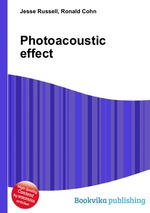Photoacoustic effect
Jesse Russell Ronald Cohn
бумажная книга
High Quality Content by WIKIPEDIA articles! The photoacoustic (or optoacoustic) effect is, in essence, the formation of sound waves, following light absorption in a material sample. In order to obtain this effect the light intensity must vary, either periodically (modulated light) or as a single flash (pulsed light). The photoacoustic effect is quantified by measuring the formed sound (pressure changes) with appropriate detectors, such as microphones or piezoelectric sensors. The time variation of the electric output (current or voltage) from these detectors is the photoacoustic signal. These measurements are useful to determine certain properties of the studied sample. For example, in photoacoustic spectroscopy, the photoacoustic signal is used to obtain the actual absorption of light in either opaque or transparent objects. (Transparent objects are not suitable for common absorption spectroscopy because of the scattering of light.) Photoacoustics is impervious to this scattering since absorbed light alone can create a signal. It is also useful for substances in extremely low concentrations, because very strong pulses of light from a laser can be used to increase sensitivity and very narrow wavelengths can be used for specificity. Furthermore, photoacoustic measurements serve as a valuable research tool in the study of the heat evolved in photochemical reactions (see: photochemistry), particularly in the study of photosynthesis.


